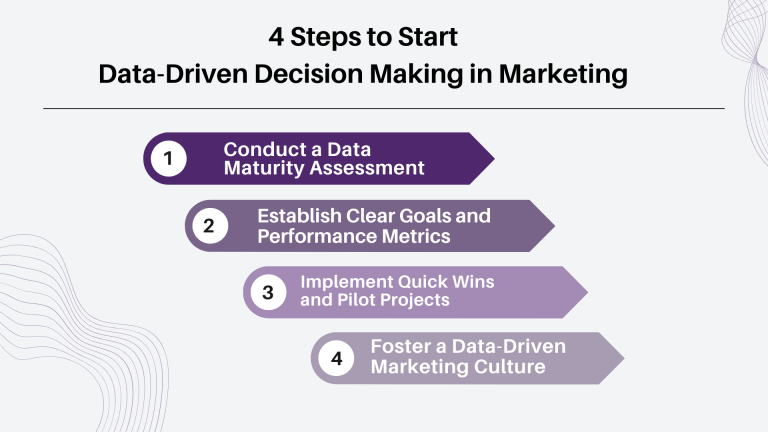What is Data-Driven Decision Making (DDDM)?
In today’s fast-paced business environment, data has become the lifeblood of effective marketing strategies. Using data insights is now a must for organizations that want to stay ahead of the competition. Collecting data is a crucial first step in leveraging the power of data-driven decision-making.
Data-Driven Decision Making (DDDM) is the process of using data analytics and big data to inform marketing choices. It uses data analytics and extensive datasets to inform marketing choices. This approach helps marketers make informed decisions, optimize campaigns, and deliver personalized experiences that resonate with customers.
It has become a powerful tool in the marketing industry. A study conducted by McKinsey found that companies using customer analytics extensively outperform their competitors in acquiring and retaining loyal customers. These companies have a higher success rate in attracting new customers and maintaining their loyalty. This demonstrates the importance of utilizing customer analytics in gaining a competitive edge.

By embracing DDDM, businesses can unlock a wealth of opportunities to drive growth, enhance customer engagement, and stay ahead of market trends. For example, 72% of customers only engage with brands that offer personalized communications, highlighting the importance of data-driven targeting and customization [2].
Data-driven marketing helps organizations understand their target audience. It also helps them find important points in the customer journey. This allows them to create campaigns that give better returns on investment. Moreover, the statistic that 72% of customers only engage with brands that offer personalized communications reinforces the significance of data-driven strategies in capturing customer attention and fostering loyalty.
Marketing is evolving. Companies that prioritize data-driven decision-making (DDDM) can adapt to customer preferences and remain competitive in their respective markets.
By reading the following blog, you will be able to understand that DDDM is the process of using data analytics and big data to inform marketing choices and the importance of it. The adoption of data-driven strategies has become increasingly crucial for businesses looking to thrive in the digital age. According to a survey by Deloitte, companies with the strongest data-driven cultures are twice as likely to significantly exceed their business goals compared to those with weaker data-driven cultures, emphasizing the importance of fostering a data-centric mindset within the organization [3].
The Benefits of Data-Driven Decision Making in Marketing:
1. Improved Targeting and Personalization
- DDDM enables marketers to leverage customer data, behavior patterns, and preferences to create highly targeted and personalized campaigns. According to McKinsey, data-activated marketing can increase total sales by 15 to 20%, with increases of up to 30% in some cases [1].
By analyzing data insights, businesses can segment audiences precisely, tailor messaging, and deliver relevant content, products, or services that meet specific customer needs by digital transformation. Salesforce’s analysis report shows that 73% of customers expect companies to understand their unique needs and expectations [2].
2. Enhanced Campaign Performance and ROI
- Data-driven marketing strategies allow for continuous optimization and refinement of campaigns based on real-time data analysis. Marketers can improve their strategies by monitoring key performance indicators (KPIs) and using advanced analytics. This helps them identify areas for improvement, allocate resources more effectively, and maximize return on investment (ROI).
- Marketers can use data to make decisions and make sure their marketing strategies are based on solid insights. This leads to improved outcomes and a greater return on investment for marketing efforts.
3. Better Customer Insights and Engagement
- DDDM provides a deep understanding of customer behavior, preferences, and journeys. Marketers can find out what customers want and what problems they have by analyzing data from different sources. These sources include website interactions, social media activity, and past purchases. By analyzing this data, marketers can better understand their customers and tailor their strategies to meet their needs.
- According to Salesforce, more than 60% of consumers are comfortable with companies using relevant personal information in a transparent and beneficial manner [2]. This allows businesses to deliver more relevant and engaging experiences, fostering stronger customer relationships and loyalty.
4. Faster Decision-Making and Agility
- In today’s rapidly evolving market landscape, the ability to make data-driven decisions quickly is crucial. DDDM empowers marketers with real-time data and analytics. This enables them to swiftly respond to new trends, customer feedback, and competitive actions.
- This agility allows businesses to seize opportunities, mitigate risks, and adapt their strategies for optimal performance. Marketers can use data insights to make quick, smart decisions. This helps ensure that their campaigns remain relevant and effective as the market changes.
Key Components of Data-Driven Decision Making in Marketing
1. Data Collection and Integration:
- The foundation of DDDM lies in collecting and integrating data from various sources, including website analytics, customer relationship management (CRM) systems, social media platforms, and third-party data providers. Ensuring data quality, consistency, and accessibility is crucial for effective analysis and decision-making.
2. Data Analysis and Insights Generation:
- Leveraging advanced analytics tools and techniques, such as predictive modeling, machine learning, and data mining, businesses can uncover valuable insights from their data. These insights can reveal customer behavior patterns, identify trends, and inform strategic decision-making processes.
3. Data Visualization and Reporting
- Leveraging advanced analytics tools and techniques, such as predictive modeling, machine learning, and data mining, businesses can uncover valuable insights from their data. These insights can reveal customer behavior patterns, identify trends, and inform strategic decision-making processes.
4. Data-Driven Strategy and Execution:
- DDDM goes beyond merely analyzing data; it involves translating insights into actionable strategies and executing them effectively. This may include optimizing marketing campaigns, refining product offerings, adjusting pricing strategies, or tailoring customer experiences based on data-driven decisions.
Challenges and Considerations
1. Data Quality and Accessibility
- Ensuring the accuracy, completeness, and accessibility of data is a critical challenge. Inconsistent or siloed data can lead to flawed insights and suboptimal decision-making. Implementing robust data governance practices and integrating data sources are essential to overcome this hurdle.
2. Skills and Talent Requirements
- Adopting DDDM requires a skilled workforce proficient in data analysis, statistical modeling, and technology tools. Organizations may need to invest in training existing employees or attracting talent with specialized data and analytics expertise.
3. Technology and Infrastructure Investments:
- Implementing DDDM often necessitates investments in data management systems, analytics platforms, and supporting technologies. Businesses must carefully evaluate their technology needs and allocate resources accordingly to enable data-driven marketing strategies.
4. Privacy and Ethical Concerns
- As data becomes increasingly central to marketing efforts, organizations must prioritize data privacy and ethical practices. Adhering to data protection regulations, ensuring transparency, and respecting customer consent are crucial for maintaining trust and avoiding legal and reputational risks. The General Data Protection Regulation (GDPR) in the European Union and the Personal Information Protection Law (PIPL) in China are examples of regulations that organizations must comply with when handling customer data.

4 Steps to start Data-Driven Decision Making in Marketing
1. Conduct a Data Maturity Assessment
- Evaluate the quality, accessibility, and integration of your marketing data sources
- Assess your current analytics tools, processes, and infrastructure
- Identify gaps in your marketing team’s data skills and expertise
- Benchmark your organization’s data maturity against industry standards and best practices
- Create a roadmap for enhancing your data capabilities and advancing your data maturity level
2. Establish Clear Goals and Performance Metrics:
- Define specific, measurable, achievable, relevant, and time-bound (SMART) goals that align with your overall business objectives
- Identify the key performance indicators (KPIs) that will help you track progress towards your goals
- Set realistic targets and benchmarks for each KPI based on historical data and industry benchmarks
- Ensure that your goals and metrics are well-communicated and understood across your marketing team and stakeholders
- Regularly review and adjust your goals and KPIs as needed based on changing business priorities and market conditions
3. Implement Quick Wins and Pilot Projects
- Identify low-risk, high-impact opportunities to demonstrate the value of data-driven marketing
- Prioritize pilot projects that can be implemented quickly and with minimal resources
- Focus on use cases that address critical business challenges or provide significant benefits to your target audience
- Measure and document the results of your pilot projects to build a business case for larger-scale initiatives
- Celebrate and communicate the successes of your quick wins to gain stakeholder buy-in and support”
4. Foster a Data-Driven Marketing Culture:
- Provide training and development opportunities to upskill your marketing team in data analysis, interpretation, and visualization
- Encourage cross-functional collaboration and data sharing between marketing and other departments (e.g., sales, customer service, IT)
- Establish clear processes and guidelines for data-driven decision making, including data governance, privacy, and ethics
- Lead by example and demonstrate the value of data-driven insights in your own decision making and communication
- Recognize and reward individuals and teams who effectively leverage data to drive marketing performance and business results
Takeaway from Data-Driven Decision Making in Marketing
In today’s business world, using data to make decisions in marketing is important for staying competitive and successful.” By leveraging data insights, businesses can enhance personalization, improve campaign performance, unlock customer insights and build stronger loyalty and relationships.
To succeed with DDDM, organizations must first evaluate their data maturity. They should then establish specific goals and start pilot projects. It is important to promote a culture that values data-driven decisions. Additionally, making data privacy and compliance a top priority is crucial.
Despite challenges, the benefits of DDDM far outweigh the obstacles. By harnessing the power of data and analytics, businesses can make informed, agile decisions that drive meaningful results and maintain a competitive edge in today’s data-driven world. Organizations that embrace DDDM will be better positioned to adapt to changes, deliver exceptional customer experiences, and achieve sustainable growth.
References:
[1] “The heartbeat of modern marketing: Data activation and personalization” by Julien Boudet, Brian Gregg, Jason Heller, and Caroline Tufft, McKinsey, https://www.mckinsey.com/capabilities/growth-marketing-and-sales/our-insights/the-heartbeat-of-modern-marketing
[2] “Data-Driven Marketing: How to Spend Less and Deliver More” by Salesforce, Salesforce Blog, https://www.salesforce.com/ap/blog/data-driven-marketing/
[3] “Analytics and AI-driven enterprises thrive in the Age of With” by Thomas H. Davenport, Jim Guszcza, Tim Smith, and Ben Stiller, Deloitte Insights, https://www2.deloitte.com/us/en/insights/topics/analytics/insight-driven-organization.html
Contact NOVA for Professional Digital Transformation Service
NOVA’s services empower businesses to thrive in the data-driven era. Our team of experts understands the critical role of data in driving informed decision-making and delivering personalized customer experiences. With our cutting-edge analytics capabilities and deep industry knowledge, we can help you unlock the full potential of your data assets. From collecting and integrating data sources to extracting valuable insights, we provide end-to-end solutions tailored to your specific business needs.
Contact NOVA to embrace data-driven decision-making and gain a competitive edge in your respective markets now!












